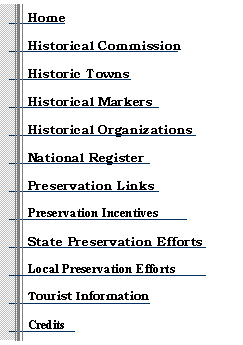
 1. Friendship Baptist Church (1911)
1. Friendship Baptist Church (1911) 426 Northwest 2nd Street
The Reverend Richard E. Shiv-ery, a city commissioner in 1882, deeded this lot to the trustees of the St. John the Baptist Church in 1891. The earlier frame church burned in 1911 and was replaced by the present Romanesque Gothic Revival church. It stands as a good example of the use of rusticated concrete block.
 2. Chapin House (1886)
2. Chapin House (1886) 320 Northwest 1st Street
J.C Chapin built this fine example of the Italianate influence on local architecture. At one time it was converted into apartments. By 1975 the house had so deterio-rated that it was condemned to be razed. Sande and Keifer Calkins purchased it in 1984, totally re-stored the house and added an elaborate two-story front porch. The interior displays a fireplace, window trim and moldings made of burled heart pine or "rosewood," while the stairway balusters alternate pine and cherry.
 3. Thomas House (c.1894)
3. Thomas House (c.1894)110 Northwest 4th Avenue
Built as the residence of Dr. R Thomas, an early Gainesville doctor and founder of the Williams Thomas Funeral Home, this house was renovated and remodeled in 1960 by Reba Lee Bryan and her husband. Its Queen Anne style is expressed in the asymmetrical one-story porch with Ionic columns, pyramidal roof with intersecting gable and bargeboard with applied lozenges. Mrs. Bryan is a founding member of the Pleasant Street Historical Society.

4. Tuttle-Clark House (c.1897)
116 Northwest 4th Avenue
Built and occupied by carpenter J.H. Tuttle, this Queen Anne home was later owned and occupied by James Clark, a piano tuner. The decorative woodwork in the gable and on the veranda and the ap-plied ornamentation on the barge-boards were added in 1986.
 5. La Fontisee House (c.1889)
5. La Fontisee House (c.1889)214 Northwest 4th Avenue
Wade Geiger was probably the builder of this house, but it was occupied from 1894 to 1925 by the La Fontisee family who had come to Florida in 1886. John La Fontisee, a member of the Gainesville Guards, had twelve children. Four of his daughters had their weddings in the house's double parlors, while the youngest, Caroline, operated a small school in the house around 1908.

6. Davis House (c.1875)
232 Northwest 4th Avenue
An outstanding example of the Queen Anne style, this one-story house features turned porch details and wagon wheel brackets. One of the oldest houses in the District, it has had many owners, including Mrs. Annie Davis.
7. Whittstock House (c.1887)
320 Northwest 3rd Street
This important example of the Eastlake style is considered one of the most significant buildings in the city. Note the elaborate porches with brackets, braces and carved posts and the intricate roofline. Alexander E Whittstock, a blacksmith, master carpenter and real estate investor, built this house, and others in this neighborhood.
8. Saunders House (1897)
116 Northwest 3rd Street
This house was bought and occupied by M.B. Saunders, the owner of a downtown merchandise store. This Queen Anne house has a steep pyramid roof pierced by gables with gingerbread ornaments. The spindlework frieze under the roof of the veranda is interrupted by bracketed posts.
9. Parker-Cosby House (c. 1877)
303 Northwest 4th Street
This two-story frame house was the birthplace of Julius W. Parker, one of Gainesville's first black doctors and owner of the Parker Drug Company. Moved from its original location, east to west on the same lot, in 1910, it remains the residence of Dr. Parker's daughter Julia and her husband, Dr. Edgar Cosby, a dentist.
10. Hendley House (1909)
319 Northwest 4th Avenue
Samuel H. Hendley operated a grocery store on Pleasant Street and served as deacon of the Friendship Baptist Church. His wife still resides in this two-story vernacular home.
11 . Garrison Nursery School (c.1934)
626-628 Northwest 4th Street
Bessie Marie Garrison operated a nursery school in this building, which was built with WPA funds during the Depression. She also operated a boarding school for young women. There were a number of private schools in the Pleasant Street district and many families boarded students who lived in rural Alachua County.
12. Cook House (c.1880s)
710 Northwest 4th Street
Sam and Fannie Cook built this frame vernacular house sometime in the 1880s. Sam Cook was a carpenter, while his wife's brother, Jennings Feltner, became the Gainesville Tax Assessor in 1888. The original house was side gabled and the porch with its gable facing the street was a later addition. The Cook family still owns and occupies the house.
13. Smith House (c.1880)
321 Northwest 8th Avenue
George and Rosetta Smith came to Gainesville from South Carolina around 1870. Their son Vir-gil was born in this house in 1880. His daughter Claranell completed graduate studies at Columbia and taught for many years in St. Pe-tersburg. She still resides in this traditional "I" house.

14. Mt. Pleasant United Methodist Church (1904)
620 Northwest 2nd Street
The site for this church was purchased in 1867 and the original, woodframe church, built by 1884, burned in 1903. This handsome, red brick Romanesque Revival replacement building with stained glass windows was completed in 1906. An outstanding neighborhood landmark, it remains the oldest black church in Gainesville.
Photographs by Jennifer Moreau
